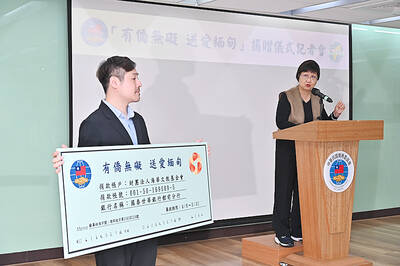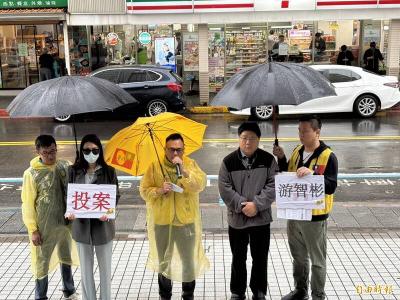The Government Information Office (GIO) yesterday refused to comment on reports showing a tightening of media controls in China and said it would maintain its plan to further open Taiwan to Chinese journalists.
Chinese social media were abuzz over the weekend after remarks by the new head of China Central Television (CCTV), who said that the first job of a journalist was to serve as a “mouthpiece” for the state, were leaked on the Internet.
Hu Zhanfan (胡占凡), who took the reins at CCTV last month, said journalists who believed they were independent professionals rather than “propaganda workers” were making a “fundamental mistake.”
Although Hu had made the comments at a special forum on “fake news” in January, they quickly spread after they were posted on a Chinese microblogging site over the weekend. Angered by signs that the media environment was failing to liberalize, some Chinese Internet users likened Hu to Nazi propagandist Joseph Goebbels.
By yesterday, the posting had attracted more than 10,000 responses, though most were quickly removed by censors.
The Central Committee of the Chinese Communist Party (CCP) announced last month that Hu, a former vice minister of the State Administration of Radio, Film and Television, the regulator for some of the largest media industries in China, had been appointed president of CCTV. Hu is also a former editor of the Guangming Daily, a newspaper published by the CCP’s Central Propaganda Department.
Meanwhile, developments in Hong Kong prompted the Wall Street Journal to write on Sunday that smear campaigns launched by pro-Beijing media were “plumbing new depths of defamation.”
At issue was a campaign by Hong Kong media accusing pro-democracy politicians of being “stooges of foreign powers” as the territory holds district council elections and prepares for the selection of the 1,200 elites who will choose the territory’s next chief executive later this month.
Publications controlled by Chinese interests have accused Jimmy Lai (黎智英), founder of Apple Daily, of acting as a conduit for foreign money and influence to “unpatriotic” elements and “traitors” within the pro-democracy camp. The head of the local Catholic Church, Cardinal Joseph Zen (陳日君), has also faced similar accusations for his support of the democratic camp.
Eastweek magazine, which is owned by a member of the Standing Committee of the Chinese People’s Political Consultative Conference, claimed Lai did not have the resources to make the US$5.4 million in donations he is said to have made over seven years and alleged that the funds came from the US government, the Journal said.
Lai denies the allegations and is suing the magazine for libel.
The China Daily, Ta Kung Pao and Hong Kong Commercial Daily have made similar allegations, while the South China Morning Post — the only non-state controlled media among them — ran an opinion piece by a member of the Standing Committee of the National People’s Congress accusing Zen of funding underground churches in China and treason.
While refusing to comment on the developments, Chang Hui-chun (張惠君), a senior editor at the Department of Planning, the section in charge of cross-strait media exchanges at the GIO, said the government would proceed with plans to open the country to more Chinese journalists.
“I fail to see why [the Chinese government] has adopted those policies, but I can’t really comment on that because [China] has a different system than what we have in Taiwan, where people fully enjoy freedom of speech,” Chang said.
The GIO encourages cross-strait exchanges between personnel of various media outlets, motion picture corporations and publishing companies in the field of journalism and culture, she said.
Last year, the number of visits by Chinese media professionals to co-produce TV series, movies or books or to cover feature stories was between 4,000 and 5,000, up from about 1,000 in 2008, Chang said.
The government not only leaves the door open to promote cross-strait media and cultural exchanges, but has also eased restrictions on Chinese journalists stationed in Taiwan by allowing 10 Chinese media outlets to each deploy five reporters, up from three media outlets with each having a maximum three reporters in 2008, she said.
“With the exchanges increasing, we believe people from both sides can have more understanding of the other side,” Chang said.
There were some “limitations” on reports by Chinese journalists stationed in Taiwan, she said.
“For example, a journalist said he did not know that Taiwanese could travel to 124 countries or regions without visas until he came to Taiwan, but he couldn’t write a story on this,” she said.
Despite the limitations, some have written stories about their experiences in Taiwan, such as people waiting for garbage trucks rather than throwing garbage on the ground anytime, she said.
In September, a delegation of about 20 representatives from 10 major media organizations in China, including Xinhua, the People’s Daily, the Economic Daily News, China National Radio, China Radio International and CCTV visited Taiwan, during which calls were made for closer media cooperation across the Taiwan Strait. State Council Information Office Deputy Director Wang Guoqing (王國慶) and Central Committee Propaganda Department Information Bureau Deputy Secretary Zhang Ye (張燁) were part of the group. This was the third visit by a Chinese media delegation since March 2009.

DEFENSE: The National Security Bureau promised to expand communication and intelligence cooperation with global partners and enhance its strategic analytical skills China has not only increased military exercises and “gray zone” tactics against Taiwan this year, but also continues to recruit military personnel for espionage, the National Security Bureau (NSB) said yesterday in a report to the Legislative Yuan. The bureau submitted the report ahead of NSB Director-General Tsai Ming-yen’s (蔡明彥) appearance before the Foreign and National Defense Committee today. Last year, the Chinese People’s Liberation Army (PLA) conducted “Joint Sword-2024A and B” military exercises targeting Taiwan and carried out 40 combat readiness patrols, the bureau said. In addition, Chinese military aircraft entered Taiwan’s airspace 3,070 times last year, up about

A magnitude 4.3 earthquake struck eastern Taiwan's Hualien County at 8:31am today, according to the Central Weather Administration (CWA). The epicenter of the temblor was located in Hualien County, about 70.3 kilometers south southwest of Hualien County Hall, at a depth of 23.2km, according to the administration. There were no immediate reports of damage resulting from the quake. The earthquake's intensity, which gauges the actual effect of a temblor, was highest in Taitung County, where it measured 3 on Taiwan's 7-tier intensity scale. The quake also measured an intensity of 2 in Hualien and Nantou counties, the CWA said.

The Overseas Community Affairs Council (OCAC) yesterday announced a fundraising campaign to support survivors of the magnitude 7.7 earthquake that struck Myanmar on March 28, with two prayer events scheduled in Taipei and Taichung later this week. “While initial rescue operations have concluded [in Myanmar], many survivors are now facing increasingly difficult living conditions,” OCAC Minister Hsu Chia-ching (徐佳青) told a news conference in Taipei. The fundraising campaign, which runs through May 31, is focused on supporting the reconstruction of damaged overseas compatriot schools, assisting students from Myanmar in Taiwan, and providing essential items, such as drinking water, food and medical supplies,

New Party Deputy Secretary-General You Chih-pin (游智彬) this morning went to the National Immigration Agency (NIA) to “turn himself in” after being notified that he had failed to provide proof of having renounced his Chinese household registration. He was one of more than 10,000 naturalized Taiwanese citizens from China who were informed by the NIA that their Taiwanese citizenship might be revoked if they fail to provide the proof in three months, people familiar with the matter said. You said he has proof that he had renounced his Chinese household registration and demanded the NIA provide proof that he still had Chinese